CCNPv8 ENCOR (Version 8.0) – L2 Redundancy Exam
1. What is the goal of Layer 3 switching?
- to process packets at Layer 2 switching speeds while utilizing the scalability of routing
- to provide a better path to the Internet without using routing protocols
- to implement the routing process by using routed protocols
- to integrate all of the networking functions into one device
2. Which two statements are true about routed ports on a multilayer switch? (Choose two.)
- To create a routed port requires removal of Layer 2 port functionality with the no switchport interface configuration command.
- A routed port is a physical switch port with Layer 2 capability.
- A routed port is not associated with a particular VLAN.
- A routed port behaves like a regular router interface and supports VLAN subinterfaces.
- The interface vlan global configuration command is used to create a routed port.
3. Which two statements are true about the 802.1Q trunking protocol? (Choose two.)
- The native VLAN interface configurations must match at both ends of the link or frames could be dropped.
- Untagged frames will be placed in the configured native VLAN of a port.
- Private VLAN configurations are not supported.
- It is a proprietary protocol that is supported on Cisco switches only.
4. Which technology does CEF switching use on Cisco hardware-based routers to forward packets?
- router general-purpose CPU
- interVLAN routing using subinterfaces
- forwarding engines implemented in specialized ASICs
- route processors using stateful switchover
5. What type of specialized memory is used to facilitate high performance switching in Cisco multilayer switches?
- address resolution protocol (ARP) memory
- ternary content addressable memory (TCAM)
- Cisco Express Forwarding (CEF) memory
- content-addressable memory (CAM)
6. Which protocol is required for Cisco Express Forwarding to be able to successfully forward packets on a multilayer switch?
- VLAN Trunking Protocol
- Cisco Discovery Protocol
- Spanning Tree Protocol
- Address Resolution Protocol
- Dynamic Trunking Protocol
7. Which two network design features require Spanning Tree Protocol (STP) to ensure correct network operation? (Choose two.)
- link-state dynamic routing that provides redundant routes
- removing single points of failure with multiple Layer 2 switches
- implementing VLANs to contain broadcasts
- static default routes
- redundant links between Layer 2 switches
8. If left to default configuration settings, what will determine which switch becomes the spanning-tree root bridge in a Layer 2 domain?
- the highest bridge priority
- the lowest switch MAC address
- the highest bridge ID
- the highest management IP address
9. During the implementation of Spanning Tree Protocol, all switches are rebooted by the network administrator. What is the first step of the spanning-tree election process?
- Each switch determines the best path to forward traffic.
- All the switches send out BPDUs advertising themselves as the root bridge.
- Each switch determines what port to block to prevent a loop from occurring.
- Each switch with a lower root ID than its neighbor will not send BPDUs.
10. After the election of the root bridge has been completed, how will switches find the best paths to the root bridge?
- Each switch will analyze the sum of the hops to reach the root and use the path with the fewest hops.
- Each switch will analyze the port states of all neighbors and use the designated ports to forward traffic to the root.
- Each switch will analyze the BID of all neighbors to reach the root and use the path through the lowest BID neighbors.
- Each switch will analyze the sum of all port costs to reach the root and use the path with the lowest cost.
11. Which statement describes the term bridge priority in the operation of STP?
- It is a value that decides which switch can become the root bridge.
- It is a value that is used, in the event of a loop, to decide which port on the switch must be put into forwarding state.
- It is a feature that allows access ports to bypass the earlier learning and listening states and forward traffic immediately.
- It is a safety mechanism that shuts down ports configured with STP portfast upon receipt of a BPDU.
12. Which three components are combined to form a bridge ID?
- MAC address
- cost
- bridge priority
- IP address
- port ID
- extended system ID
13. In which two port states does a switch learn MAC addresses and process BPDUs in a PVST network? (Choose two.)
- listening
- disabled
- learning
- forwarding
- blocking
14. Which STP priority configuration would ensure that a switch would always be the root switch?
- spanning-tree vlan 10 priority 0
- spanning-tree vlan 10 priority 61440
- spanning-tree vlan 10 priority 4096
- spanning-tree vlan 10 root primary
15. Refer to the exhibit. The network has converged and Switch_6 has been elected root bridge of the STP tree. However, network traffic analysis indicates that Switch_1 would be a better root bridge. How can the network administrator make this change, assuming that the spanning-tree priorities are at the default settings?
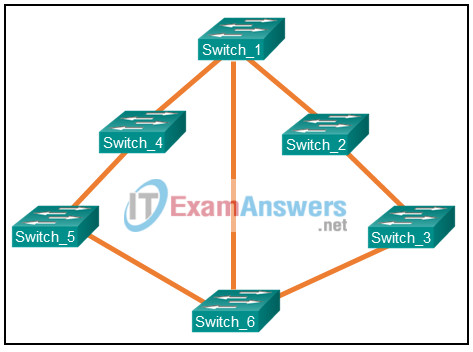
- Set the bridge priority of Switch_1 to 4,096.
- Set the bridge priority of Switch_6 to 255.
- Set the bridge priority of Switch_6 to 65,565.
- Set the bridge priority of Switch_1 to 32,768.
16. Why is it important that the network administrator consider the spanning-tree network diameter when choosing the root bridge?
- BPDUs may be discarded because of expiring timers.
- The network diameter limitation is 9.
- The cabling distance between the switches is 100 meters.
- Convergence is slower as the BPDU travels away from the root.
17. A network administrator enters the spanning-tree portfast bpduguard default command. What is the result of this command being issued on a Cisco switch?
- Any switch port that receives a BPDU will ignore the BPDU message.
- Any switch port will be error-disabled if it receives a BPDU.
- Any trunk ports will be allowed to connect to the network immediately, rather than waiting to converge.
- Any switch port that has been configured with PortFast will be error-disabled if it receives a BPDU.
18. In what situation would a network administrator most likely implement root guard?
- on all switch ports that connect to a Layer 3 device
- on all switch ports that connect to another switch
- on all switch ports that connect to host devices
- on all switch ports (used or unused)
- on all switch ports that connect to another switch that is not the root bridge
19. Which two statements describe the MST internal spanning tree instance? (Choose two)
- It carries all VLANs traffic.
- It carries identical setup information among interconnected MST regions.
- It is always instance 0.
- It runs on all switch port interfaces of switches that are designated as root bridges.
- It runs on all switch port interfaces of switches in the MST region.
20. What are the two options that describe the effects of the spanning-tree portfast command? (Choose two.)
- Portfast bypasses the learning state and moves immediately into blocking.
- If a switch port is configured with PortFast, it is an access port that immediately transitions from a blocking to forwarding state.
- Portfast enables the port to bypass the listening and learning states of STP.
- Enabling PortFast on trunks that connect to other switches improves convergence.
- If the switch port is configured with PortFast, it waits 15 seconds before transitioning from a blocking to forwarding state.
21. Which LACP technology is used for designating a specific number of member interfaces that must remain active in order for the EtherChannel bundle to be usable?
- LACP port priority
- LACP fast
- LACP min-links
- LACP system priority
22. Which statement describes the term root port in the operation of STP?
- It indicates that the port has transitioned from a blocking state and can send or receive BPDUs, but cannot forward any other network traffic.
- It is a port state that can forward all network traffic and can update the MAC address table.
- It is a port state that can modify the MAC address table with any network traffic that it receives, but only forwards BPDUs and not any other network traffic.
- It is a port that connects to the root bridge or an upstream switch in the spanning-tree topology.
23. What are two configuration parameters that must match for all switches in the same MST region? (Choose two.)
- bridge priority
- region name
- version number
- trunk link encapsulation method
- port status
24. Assuming that all switches in a network have the default bridge priority for each MST instance, what effect does the command spanning-tree mst 10 root seconday have when entered on a single switch?
- sets the bridge priority on the switch to 28672 for MST instance 10
- sets the bridge priority on the switch to 24586 for MST instance 10
- sets the bridge priority on the switch to 24582 for MST instance 10
- sets the bridge priority on the switch to 24576 for MST instance 10
25. Refer to the exhibit. A network administrator issues the show spanning-tree command to verify the MST configuration. Which two conclusions can be drawn based on the output? (Choose two.)
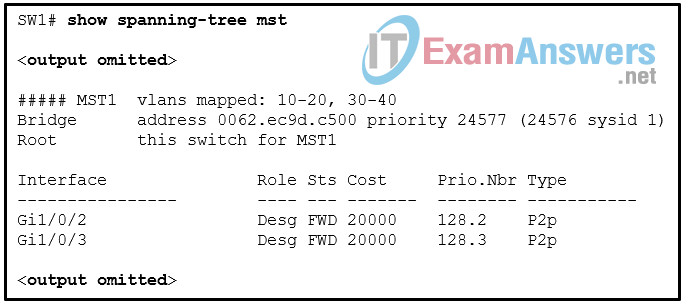
- SW1 is running IEEE 802.1W STP protocol.
- SW1 is the root bridge for instance 1.
- The command spanning-tree mst 1 root secondary was entered.
- SW1 is running IEEE 802.1S protocol.
- PortFast is enabled on ports Gi1/0/2 and Gi1/0/3.
26. Refer to the exhibit. A network administrator is configuring MST tuning on SW1. The objective is to change the path cost value of the interface Gi1/0/1 to represent a higher-speed bandwidth link. Which value could be used in the command spanning-tree mst 0 cost for this task?

- 0
- 1
- 24576
- 32768
27. What are two misconfigurations within an MST region that might introduce port blocking unintentionally? (Choose two.)
- trunk link pruning
- too many VLANs assigned to an instance
- VLAN assignment to the IST
- misconfigured revision number across the MST region
- misconfigured region name across the MST region
28. How does an MST region send VLAN information through the PVST simulation mechanism to a switch that runs PVST+?
- It sends out PVST+ BPDUs, one for each VLAN, using the information from the IST.
- It sends out one PVST+ BPDU with the information from the IST.
- It sends out one PVST+ BPDU that maps all VLANs into VLAN1.
- It sends out multiple PVST+ BPDUs, one for each VLAN, plus the IST.
29. Which two VTP modes allow for the creation, modification, and deletion of VLANs on the local switch? (Choose two.)
- transparent
- distribution
- client
- server
- slave
- master
30. Given the following configuration, which two statements are true? (Choose two.)
switch(vlan)# vtp version 2 switch(vlan)# vtp mode server switch(vlan)# vtp domain Cisco switch(vlan)# vtp password mypassword
- This switch can advertise its VLAN configuration to other switches in the Cisco domain only, but can receive advertisements from other domains.
- The password will prevent unauthorized routers from participating in the Cisco domain.
- This switch can send and receive advertisements from only the Cisco domain.
- This switch can create, modify, and delete all VLANs within the Cisco domain.
- This switch maintains a full list of all VLANs and can create VLANs, but cannot delete or modify existing VLANs.
31. Which Cisco proprietary protocol is used for dynamically forming a trunk connection between two switches?
- VTP
- STP
- DTP
- PAgP
32. Which is a characteristic of EtherChannel?
- STP treats all interfaces in an EtherChannel bundle as a single logical link.
- EtherChannel uses physical ports that have been upgraded to provide a faster connection.
- EtherChannel configuration is applied to each physical port.
- STP will not block redundant EtherChannel bundles between two switches.
33. Refer to the exhibit. The administrator tried to create an EtherChannel between S1 and the other two switches via the commands that are shown, but was unsuccessful. What is the problem?
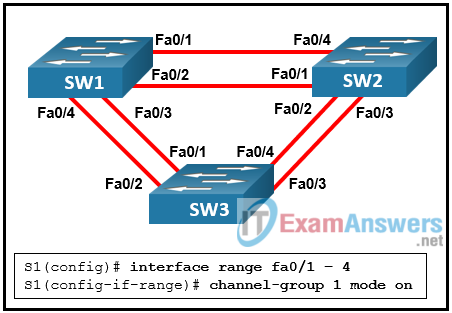
- Traffic can only be sent to two different switches if EtherChannel is implemented on Gigabit Ethernet interfaces.
- Traffic can only be sent to two different switches if EtherChannel is implemented on Layer 3 switches.
- Traffic cannot be sent to two different switches, but only to two different devices like an EtherChannel-enabled server and a switch.
- Traffic cannot be sent to two different switches through the same EtherChannel link.
34. Refer to the exhibit. An EtherChannel was configured between switches S1 and S2, but the interfaces do not form an EtherChannel. What is the problem?
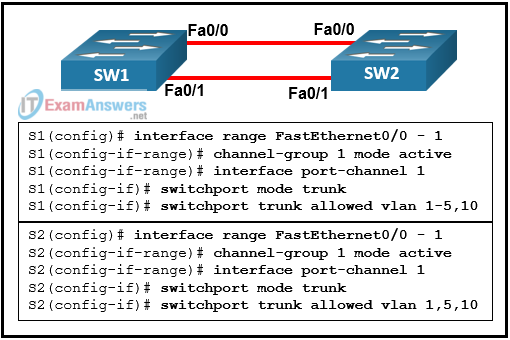
- The EtherChannel was not configured with the same allowed range of VLANs on each interface.
- The switch ports were not configured with speed and duplex mode.
- The switch ports have to be configured as access ports with each port having a VLAN assigned.
- The interface port-channel number has to be different on each switch.
35. Which two DTP mode combinations will form a trunk link between two switches? (Choose two.)
- access and dynamic auto
- dynamic auto and dynamic auto
- trunk and access
- trunk and dynamic desirable
- dynamic auto and dynamic desirable
36. Which statement is true about the port roles of the 802.1w Rapid Spanning Tree Protocol?
- Cisco-proprietary enhancements to the legacy 802.1D, such as UplinkFast and BackboneFast, are compatible with RSTP.
- An alternate or backup port can immediately change to a forwarding state without waiting for the network to converge.
- It takes an edge port 15 seconds to go from blocking to forwarding.
- Ports are manually configured to be in the designated role.
37. Which technology is used to protect the switched infrastructure from problems caused by receiving BPDUs on ports that should not be receiving them?
- Loop guard
- PortFast
- BPDU guard
- RSPAN
- Root guard
38. Which statement describes the term blocking in the operation of STP?
- It is a port state that can modify the MAC address table with any network traffic that it receives, but only forwards BPDUs and not any other network traffic.
- It indicates that the port is in an administratively off position.
- It is a port state that is enabled but does not forward any traffic to ensure that a loop does not occur.
- It indicates that the port has transitioned from a blocking state and can send or receive BPDUs, but cannot forward any other network traffic.
39. The network administrator wants to configure a switch to pass VLAN update information to other switches in the domain but not update its own local VLAN database. Which two steps should the administrator perform to achieve this? (Choose two.)
- Configure VTP version 1 on the switch.
- Configure the switch with the same VTP domain name as other switches in the network.
- Verify that the switch has a higher configuration revision number.
- Reset the VTP counters.
- Configure the VTP mode of the switch to transparent.
40. Which LACP technology is used for designating whuch member interfaces will be active in a port-channel configuration where there are more member interfaces than the maximum allowed?
- LACP min-links
- LACP port priority
- LACP system priority
- LACP fast
41. Which LACP technology can identify and remove a LACP enabled link from an EtherChannel within three seconds when the link is experiencing connectivity issues?
- LACP min-links
- LACP port priority
- LACP system priority
- LACP fast
42. Which two statements descibe the MST internal spanning tree instance? (Choose two)
- It runs on all switch port interfaces of switches that are designated as root bridges.
- It is always instance 0.
- It carries identical setup information among interconnected MST regions.
- It runs on all switch port interfaces of the switches in the MST region.
- It carries all VLANs traffic.
43. Which statement describes the term root bridge in the operation of STP?
- It is a switch that is at the top of the spanning tree and whose ports are all forwarding and are all categorized as designated ports.
- It is a value that decides which switch can become the root bridge.
- It is a feature that prevents any alternative or root ports from becoming designated ports because of a loss of BPDUs on the root port.
- It is a safety mechanism that shuts down ports configured with STP portfast upon receipt of a BPDU.
44. Refer to the exhibit. Access1 is a new switch that is to be connected as a VTP client to the network once it has been configured. Given the output generated by the VTP server switch Dist-2, which series of configuration commands would successfully introduce the client switch into the VTP domain?
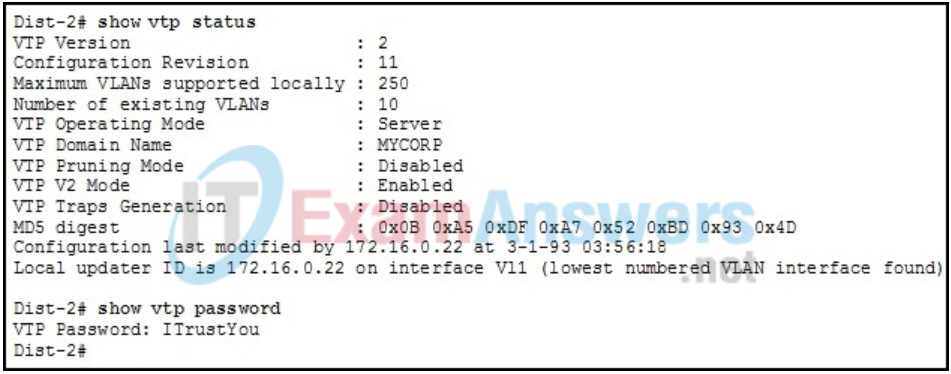
- Access1(config)# vtp mode client
Access1(config)# vtp domain MYCORP
Access1(config)# vtp version 2
Access1(config)# vtp password ITrustYou - Access1(config)# vtp mode client
Access1(config)# vtp domain mycorp
Access1(config)# vtp password ITrustYou - Access1(config)# vtp mode client
Access1(config)# vtp domain mycorp
Access1(config)# vtp password ITrustYou - Access1(config)# vtp mode client
Access1(config)# vtp domain Mycorp
Access1(config)# vtp version 2
Access1(config)# vtp password ITrustYou
45. Which LACP technology is used for designating which member interfaces will be active in a port-channel configuration where there are more member interfaces than the maximum allowed?
- LACP min-links
- LACP system priority
- LACP port priority
- LACP fast
46. Which statement describes the term root guard in the operation of STP?
- It is a feature that prevents any alternative or root ports from becoming designated ports because of a loss of BPDUs on the root port.
- It is a feature that prevents a configured port from becoming a root port.
- It is a value that decides which switch can become the root bridge.
- It is a safety mechanism that shuts down ports configured with STP portfast upon receipt of a BPDU.
47. Which statement describes the term forwarding in the operation of STP?
- It is a port state that can modify the MAC address table with any network traffic that it receives, but only forwards BPDUs and not any other network traffic.
- It is a port state that can forward all network traffic and can update the MAC address table.
- It is a port state that is enabled but does not forward any traffic to ensure that a loop does not occur.
- It indicates that the port has transitioned from a blocking state and can send or receive BPDUs, but cannot forward any other network traffic.

where can i find just the questions ?
ARE THESE QUESTIONS STILL VALID ON THE NEW CCNP EXAM
42. Which two statements descibe the MST internal spanning tree instance? (Choose two)
MST uses a special STP instance called the internal spanning tree (IST), which is always the first instance, instance 0. The IST runs on all switch port interfaces for switches in the MST region, regardless of the VLANs associated with the ports.
Dear admin, may you update the latest update on this page. Currently the Last update we can see is: Updated: Nov 21, 2021. Please confirm
29 How does an MST region send VLAN information through the PVST simulation mechanism to a switch that runs PVST+?
Which statement describes the term bridge priority in the operation of STP?
13 Which statement describes the term forwarding in the operation of STP?
13
Which statement describes the term forwarding in the operation of STP?
I think Q.61 the answer should be B, not C.
Fixed, thanks you so much!!
The IST always is in instance 0. Could confirm, please?
61. Which statement describes the term root guard in the operation of STP?
any suggestions?
Which LACP technology is used for designating which member interfaces will be active in a port-channel configuration where there are more member interfaces than the maximum allowed?
Thanks for your sharing!
Which statement describes the term root guard in the operation of STP?
Thanks for your sharing!
Which LACP technology is used for designating whuch member interfaces will be active in a port-channel configuration where there are more member interfaces than the maximum allowed?
• LACP min-links
• LACP port priority
• LACP system priority
• LACP fast
Added all (Q55, Q56, Q57), correct me if i’m wrong, many thanks for sharing!!
i think the answer is port priority
Yes, you are right. The answer in the test is wrong
Which LACP technology can identify and remove a LACP enabled link from an EtherChannel within three seconds when the link is experiencing connectivity issues?
• LACP min-links
• LACP port priority
• LACP system priority
• LACP fast
Which two statements descibe the MST internal spanning tree instance? (Choose two)
• It runs on all switch port interfaces of switches that are designated as root bridges.
• It is always instance 0.
• It carries identical setup information among interconnected MST regions.
• It runs on all switch port interfaces of the switches in the MST region.
• It carries all VLANs traffic.
lots of questions are missing here,couldnt find more than 3
Sorry! We are updating exams
7 Which two DTP mode combinations will form a trunk link between two switches? (Choose two.)
Thanks for sharing!